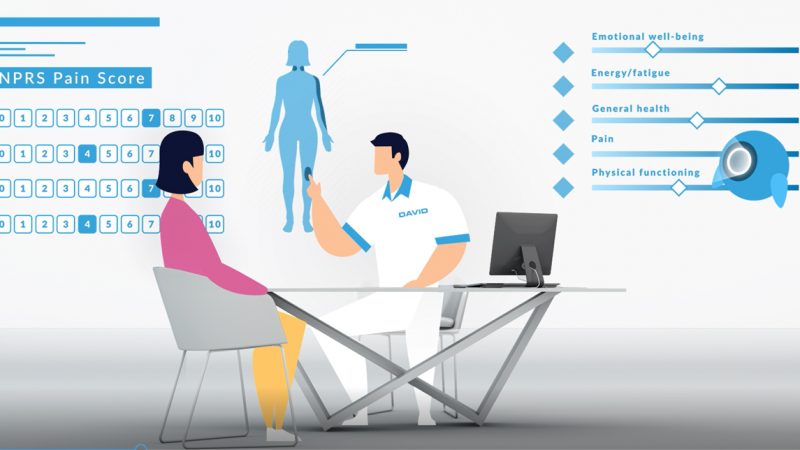Symptoms and diagnosis of rotator cuff syndrome
The muscles surrounding the shoulder joint and their tendons form the rotator cuff. With rotator cuff syndrome, the tendons in the muscles of the rotator cuff become irritated and inflamed. Inflammation results in swelling and thickening of the structures, an increase in constriction and thus a further aggravation of the irritation. The injury is often caused by excessive strain, incorrect working positions or, for example, a fall. The ailment is most common in people aged 35-50. In fact, it affects 30 to 50% of people over 50 years old.
Key components of rotator cuff syndrome treatment is to ensure that the full range of motion of the shoulder is achieved, regain the strength of the rotator cuff muscles, acknowledge the importance of scapular control in shoulder related diagnoses, and evaluate and correct the postural impact.
 G660 Glenohumeral external rotation device for shoulder pain treatment.
G660 Glenohumeral external rotation device for shoulder pain treatment.
Diagnose-based templates specify physiotherapy care
One important improvement to EVE, is the new diagnose-based program template collection that is available for all users on EVE. The ready-made templates provide rehabilitation programs for different disorders to treat the spine, neck, shoulder, hip and knee. With these templates the underlining idea is to offer a holistic approach to the rehabilitation by combining target area specific exercises with supportive exercises.

For a patient with rotator cuff syndrome, the physiotherapist assigns the diagnose-based template for rotator cuff syndrome where the importance of strength training has been taken into account. In EVE, the therapist can go through the template and make any changes to parameters including weight resistance, range-of-motion, number of repetitions and sets, etc. The template is easily customizable to meet the individual needs of the patient.
Effective exercise for musculoskeletal pain treatment
The target specific exercises include device exercises with the David Shoulder Solution. The device exercises follow safe range-of-motion parameters to safely mobilize and strengthen the shoulder, without causing stress on the joints. In addition to these target specific shoulder exercises, this diagnose-based template provides back and neck exercises as important supportive exercises.
The six shoulder exercises (done on five devices) enable the full movement direction of the shoulder joint. Glenohumeral internal and external rotation, diagonal shoulder abduction, pulldown, chest press and scapular abduction are designed to ease the shoulder rehabilitation with proper fixation and biomechanically ideal movement guidance. Click on the image below to watch the movement for the G510 Scapular Abduction.

Therefore the default rotator cuff template offers higher number of repetitions for internal rotation than for the external rotation. In addition, the number of sets differ with these movement directions. The possibility to alter all these parameters in the program template allows the individualization to be very precise. Click on the image below to watch the movement for the G660 Glenohumeral External rotation device.

Home exercises to help alleviate shoulder pain
Additional exercises are an integral part of the overall treatment program. They can be used in conjunction with device exercises and assigned to a patient to perform at home. This way therapists can ensure an ongoing therapy process even outside clinic visits. Many conditions have unique characteristics which require targeted and specific exercises to support the device exercises. By complementing device exercise programs with additional exercises, therapists can individualize the treatment program even better and make sure that every stage of rehabilitation is covered.

Here is an easy-to-follow list of home exercises for rotator cuff syndrome. Feel free to download any of the language versions below for pictures and descriptions of the suggested exercises. Please note that this list of exercises is not comprehensive. They are examples of some of the commonly used exercises for rotator cuff syndrome. Consult a physiotherapist for an individualized treatment protocol.
PDF download – Home exercises for rotator cuff syndrome
Click on the buttons below for a PDF of the home exercises. Exercise descriptions and instructions are available to download in English, Spanish, French, Dutch, and Finnish.
For more information on other musculoskeletal pain disorders, head over to our Patient Information pages. These pages provide patient information for pain problems for Spine, Shoulder, Hip and Knee. Explore our Global Reference Center pages to learn how our technology is transforming musculoskeletal health care.
Learn more about the Additional Exercise Module from the video link below! Are you interested in the Module for your center? Contact your DAVID Distributor or the DAVID Help Desk for more information.

 English
English 





























